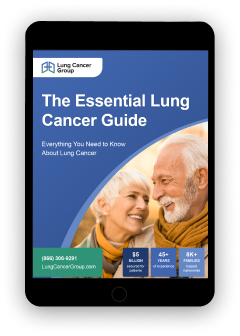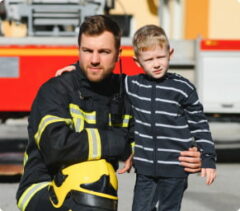Firefighters, Lung Cancer, and Mesothelioma
Firefighters risk their lives battling dangerous fires, but other unseen dangers like asbestos, threaten their health and safety. In fact, U.S. firefighters are at higher risk of lung cancer and mesothelioma due to their occupational exposure to asbestos. Learn more about the cancer risks firefighters face and what legal and financial support may be available.
About Asbestos Exposure and Firefighters
 Asbestos is a durable and fire-resistant mineral that was added to thousands of products before the 1980s. These products were used in construction, plumbing, and several other industries for decades until the dangers of the mineral became more widely understood.
Asbestos is a durable and fire-resistant mineral that was added to thousands of products before the 1980s. These products were used in construction, plumbing, and several other industries for decades until the dangers of the mineral became more widely understood.
Unfortunately, firefighters were exposed to asbestos whenever they responded to emergencies in these buildings constructed with asbestos products. This makes firefighting one of the most at-risk occupations for exposure to this mineral and other carcinogens (cancer-causing substances).
Firefighters face a 9% higher risk of cancer and 14% higher risk of death from cancer than the general population, according to studies from the National Institute for Occupational Safety and Health (NIOSH).
As a result of such high rates of asbestos exposure, firefighters are at an increased risk of asbestos-related lung cancer and mesothelioma.
Get our Free Lung Cancer Guide to see how we can assist you after a lung cancer diagnosis.

- Understand risk factors
- Find top treatments
- Pursue compensation



Firefighters and Lung Cancer
Lung cancer is the second most common cancer for both men and women in the U.S.
Many people may blame themselves for lung cancer if they have a history of smoking cigarettes, but firefighters may have been exposed to asbestos and other toxic particles that also contributed to their cancer.
Lung cancer symptoms firefighters should be aware of include:
- A cough that does not go away or gets worse
- Chest pain
- Fatigue
- Hoarseness
- Nausea
- Shortness of breath
- Vomiting
- Wheezing
If you worked as a firefighter, you should be mindful of these symptoms and any changes in your health. It may also be important to discuss your job and potential asbestos exposure with your doctor.
This will help them perform routine cancer screening and hopefully get a lung cancer diagnosis in its early stages when the cancer is easier to treat. Many lung cancer patients diagnosed early can live for years thanks to treatment.
Firefighters and Mesothelioma
Mesothelioma is a rare and aggressive cancer caused by asbestos that is sometimes confused with lung cancer. However, mesothelioma develops in the lining of the lungs, abdomen, testicles, or heart while lung cancer starts directly in the lungs.
Firefighters are twice as likely to develop mesothelioma than the general population because of the high amounts of asbestos they are exposed to, according to the National Institute for Occupational Safety and Health.
Symptoms of mesothelioma are hard to notice since they resemble symptoms of less serious conditions.
Common symptoms of mesothelioma among firefighters include:
- A persistent cough
- Difficulty breathing
- Fatigue
- Pain in the chest or abdomen
- Unexplained weight loss
- Weakness
If you worked as a firefighter decades ago, you could be at risk of developing mesothelioma today as the cancer takes 10-50 years to develop. Talk with your doctor as soon as possible if you notice any changes in your health.
Lung Cancer Group also has registered nurses experienced with mesothelioma available to help people diagnosed with this cancer get the help they need. Connect with a nurse now to see how we can help.
How Firefighters Are Exposed to Asbestos
Firefighters may have been exposed to asbestos if they responded to a burning structure that was built with asbestos-containing products.
Between the 1930s and early 1980s, asbestos was used in thousands of products, particularly construction products. Manufacturers hid the mineral’s dangers and marketed these materials as cheap, durable, and resistant to fire.
- Cement foundations
- Flooring
- Insulation
- Paint and wall textures
- Pipes
- Roofing tiles
Fires, floods, and other damage could have released asbestos fibers into the air, putting firefighters responding to emergencies at these locations at risk of exposure.
To make matters worse the fire stations and some firefighting suits they worked in also contained asbestos.
Some firefighters today could be at risk if proper precautions aren’t taken, as asbestos is still found in some older structures. For example, one recent warehouse fire in Indiana exposed firefighters responding to the emergency to airborne fibers of asbestos insulation.
Risk of Secondhand Asbestos Exposure for Firefighter Families


When asbestos fibers settle on clothing or protective gear, they can be brought home and eventually released back into the air.
This puts families and loved ones of firefighters at risk of inhaling asbestos and later developing lung cancer or mesothelioma decades later.
Other Toxic Exposures Firefighters Experience
Every firefighting scenario and environment is unique, and each has the potential to expose firefighters to hundreds of different toxic substances, in addition to asbestos.
Other carcinogens firefighters are exposed to include:
- Arsenic: This naturally occurring element can sometimes be inhaled while responding to industrial fires. It has been linked to several cancers including lung cancer, bladder cancer, and more.
- Silica dust: Firefighters may need to cut or break stones made up of crystalline silica dust — commonly used to make quartz countertops. This can release silica dust into the air that when inhaled can lead to silicosis, a serious and life-threatening lung disease.
- Sulfuric acid: Sulfuric acid can be present in smoke or mist that firefighters inhale. Exposure to this substance has been linked to laryngeal or throat cancer and lung cancer.
- PFAS or per- and poly-fluoroalkyl substances: PFAS is an ingredient in aqueous firefighting foam (AFFF) and protective equipment that has been linked to several cancers including bladder cancer. Firefighters can be exposed to PFAS when their bare skin comes in contact with AFFF or linings of protective equipment.
Being exposed to asbestos and the other occupational toxins listed above while firefighting is considered a group 1 carcinogen by the International Agency for Research on Cancer. This is the same level as smoking cigarettes.
If you or someone you love has been diagnosed with lung cancer after firefighting, we may be able to help you access financial compensation. Get started with a free case review now.
- Access Financial Aid and Justice
- Learn About Your Options
- Contact Us for Free


Firefighters and Lung Cancer Prevention
Because of how dangerous firefighting is, it’s important for firefighters to take proactive steps to prevent lung cancer.
Oftentimes, prevention involves making sure that firefighters make healthy lifestyle choices and take part in routine cancer screenings. Learn about some ways you can protect yourself from cancer as a firefighter.
Quit Smoking
Smoking cigarettes while being exposed to asbestos and other substances can further increase the risk of lung cancer. Quitting smoking can reduce the risk and protect your health.
Wear Full Personal Protective Equipment Appropriate for Each Incident
Firefighters can protect themselves by wearing the appropriate personal protective equipment (PPE) when responding to fires and having a self-contained breathing apparatus.
They should also make sure that the PPE they are using has been properly cleaned before using it again.
Improve Handling and Cleaning Methods for Protective Gear
Currently, there are no universal standards in place when it comes to cleaning personal protective equipment and ensuring that the spread of contamination is prevented.
That said, the International Association of Fire Fighters recommends several ways to reduce exposure to carcinogens in PPE.
These recommendations include:
- Do not take gear into living areas
- Transport gear in sealed bags when in personal vehicles
- Clean all skin and hair after a call to avoid any risk of exposure
By following all these steps, firefighters can hopefully lower their risk of developing lung cancer and keep their families safe from secondhand exposure to toxins.
Talk With Your Doctor About Cancer Screening
Cancer screening such as routine X-rays and CT scans may not be able to prevent lung cancer from developing, but it can help firefighters get an early diagnosis.
Getting diagnosed early greatly improves lung cancer treatment options and responses, allowing some firefighters to live for many years after their diagnosis.
Compensation Options for Firefighters with Lung Cancer and Mesothelioma
Living with lung cancer or mesothelioma can be expensive, as multiple treatments are often required as well as travel and visits to specialists. Career firefighters may also face significant expenses if they are unable to return to work after a diagnosis.
Fortunately, there are a few different forms of compensation that firefighters can seek in order to help them with these costs.
Asbestos Trust Funds
Asbestos trust funds were established when asbestos manufacturers declared bankruptcy. These funds seek to compensate victims of asbestos exposure for the illnesses they have developed.
There is currently an estimated $30 billion still available in these funds. Firefighters with asbestos-related diseases like lung cancer or mesothelioma may qualify to get trust fund compensation by working with a lawyer.
Lung Cancer Lawsuits
Because manufacturers hid the dangers of asbestos for decades, firefighters who developed lung cancer or mesothelioma may be able to pursue a lung cancer lawsuit to get justice.
Awards from these settlements or verdicts can help lung cancer victims pay for their medical costs and other damages like pain, suffering, and loss of income.
Some lung cancer victims we’ve helped have recovered millions of dollars thanks to asbestos lawsuits.
Additionally, family members of firefighters who lost their lives to occupational cancer may be able to pursue a wrongful death lawsuit.
VA Benefits
U.S. veterans who served as military firefighters were exposed to high levels of asbestos. Because of such frequent exposures to asbestos, one-third of mesothelioma patients are veterans.
Thankfully, help is available for military firefighters diagnosed with lung cancer or mesothelioma.
VA benefits for firefighters may include:
- Disability benefits, which give veterans monthly payments to cover living costs and treatment
- Survivor benefits, which help dependents of military firefighters get monthly payments or other support after they have passed from lung cancer or mesothelioma
- VA health care, which provides free or low-cost cancer treatment
Veterans with service-related mesothelioma or lung cancer often qualify for the highest disability payouts and the lowest health care copays.
Learn more about how we can help after a diagnosis with our Free Lung Cancer Guide.



- Understand risk factors
- Find top treatments
- Pursue compensation



Other Support Resources for Firefighters with Lung Cancer
Firefighters with lung cancer need to know that they are not alone, and that help is available that is specific to them and their unique situation.
Resources for firefighters with lung cancer include:
- American Cancer Society (ACS) — This organization offers information about how and why firefighters are at risk of different types of cancers and also offers opportunities for firefighters to sign up for the National Firefighter Registry and other cancer prevention studies.
- Firefighter Cancer Support Network (FCSN) — A national organization that supports firefighters and other occupational professionals by bringing awareness, education, prevention training, and support.
- International Association of Firefighters (IAFF) — This organization hosts events around the U.S. as well as a variety of resources to educate and support firefighters across several areas. It is also actively organizing to support a complete ban on asbestos.
- National Fire Protection Association (NFPA) — This group provides a variety of work-related resources for firefighting professionals, including information on how to stay up-to-date on certifications, codes, and standards.
Firefighters can also speak with their health care provider or other professionals to locate support groups and resources that are available locally.
Help Is Available for Firefighters With Lung Cancer and Mesothelioma
No one should have to suffer through a cancer diagnosis after risking their lives to protect others by putting out fires. If you or a loved one have been diagnosed with lung cancer or mesothelioma after working as a firefighter, our team at Lung Cancer Group is here to help.
We can help connect eligible firefighters with asbestos lung cancer or mesothelioma to financial compensation, allowing them to cover medical costs and any other expenses.
Compensation options for firefighters with cancer include:
- Asbestos lawsuits
- Asbestos trust funds
- VA benefits
Call (877) 446-5767 to see how we can assist you.
Asbestos Exposure and Firefighters FAQs
Do firefighters get exposed to asbestos?
Yes, firefighters can be exposed to asbestos when responding to emergencies at older buildings because asbestos products were so widely used in construction prior to the 1980s.
As a result, firefighters are two times as likely to develop mesothelioma and are at an increased risk of asbestos lung cancer.
What is the most common cancer for firefighters?
Firefighters are at risk of several cancers, especially lung cancer and mesothelioma because they could have been exposed to asbestos.
Other cancers firefighters are at risk of include:
- Bladder cancer
- Colon cancer
- Non-Hodgkin lymphoma
- Prostate cancer
- Testicular cancer
- Skin cancer
If you or a loved one has been diagnosed with cancer after working as a firefighter, you may be eligible for asbestos compensation. Get a free case review today to find out more.
What other toxic exposures do firefighters experience?
In addition to asbestos, firefighters are exposed to several carcinogens including:
- Arsenic
- Benzene
- Crystalline silica dust
- PFAS
- Radon
- Sulfuric acid
Because of this wide range of exposures, the IARC has considered the firefighting occupation as carcinogenic as smoking cigarettes.
Do firefighter suits have asbestos?
Firefighter suits are no longer made with asbestos, but the carcinogen was common in protective gear used prior to the 1980s. Asbestos is incredibly durable and fire-resistant, and at the time it was thought to be a safe material to help protect firefighters.
However, when it was no longer used, it was replaced with other cancer-causing chemicals such as PFAS. Thankfully, firefighters exposed to asbestos or PFAS can seek financial compensation. Call (877) 446-5767 to see how we can help.

